Indoor styling with plants
Plants add instant style and grace to living spaces, both indoors and out. Indoor plant specialist, Miriam Manley of Welcome Bay offers some timely advice.
Grouping and displaying indoor plants
There are a few things to consider. Think about the size of the space you are looking to style, the ambience you are trying to create and environmental conditions such as light and temperature.
When creating a group of indoor plants, play around with height, structure and form. The combinations of size, form and colour are endless and it is exciting to experiment with new and interesting groupings.
Mix contrasting foliage together. For example, a tall, structural Sansevieria contrasts well with the bold round leaves of a Calathea, which then sets the backdrop for the delicate, airy Maidenhair fern. Grouping plants in odd numbers always looks pleasing to the eye.
Have at least one large statement plant, this helps to set the style and mood of the room. Large grade specimens often have enough presence to comfortably stand alone.
Displaying houseplants in a small space
Just because you have a small space doesn’t mean you have to use small plants. Often one or two large specimens can really enhance a small space and make it seem larger, rather than cluttering it with lots of little plants in pots.
Bamboo palms (Chamaedorea seifrizii) provide this effect. They not only elicit a lush tropical feel, but have height without much width, which makes them an excellent choice for smaller spaces. Shelves and the tops of bookcases also make great spots for plants. A group of hanging plants can really enhance a small room while still leaving plenty of floor space.
Choosing pots for your indoor plants
Think about the room that the pot and plant will be going in and choose a pot that will complement the style and decor of that room. When grouping indoor plants together combine different styles and textures. For example, baskets and woven pots mixed with ceramic can look interesting and stylish.
Cover pots are an economical way of adding your style and personality to a space. Don’t be afraid to experiment with cover pots in different colours, textures and styles. A cover pot should complement the plant going inside it. There are plenty of attractive options available. Re-purposed vintage baskets, ketes and ceramic pieces can make really interesting cover pots.
Plants for a Christmas dining table
You can’t go past the classic Poinsettia in a beautiful cover pot. For something a little different try the beautifully coloured Aglaonemas, Begonia rex varieties and stunning Phalaenopsis orchids.
Top plants for rooms with low light
There are several indoor plants that are really well adapted to low light conditions. Some easy-care favourites are Sansevieria (mother-in-law’s tongue), Zanzibar Gem, Rhipsalis, Dracaena ‘Janet Craig’, Spider plant, Ferns and Aspidistra.
Plants to add drama and ambience to a living room
It is worth investing in a mature indoor plant for immediate impact and drama. Placing your specimen in a beautiful large pot will adds extra ambience. These pots don’t necessarily have to be indoor pots. There are some beautiful outdoor pots that can look stunning in an indoor space.
Some fantastic plant choices for that immediate impact are the multi trunked golden cane palm (Dypsis lutesens), kentia palm (Howea forsteriana), fiddle leaf fig (Ficus lyrata) and other Ficus species.
Plants for a bathroom
Bathrooms often have quite significant fluctuations in light, humidity and temperature throughout any given day. Use robust indoor plants such as Boston ferns, Epipremnum and Aspidistra to create a lush green space.
Little plants to suit a bedroom dresser or bedside table
Small growing indoor plants for a dresser or bedroom table include the colourful Fittonia, African violets and for a brightly lit situation there are endless options in the Cacti and Succulent family.
Getting more bang for your buck with houseplants
To create an interesting centrepiece on a budget, gather together a collection of baby houseplants that like the same conditions but have varying colours and textures. Plant them together in a wide indoor pot adding decorative items such as rocks, stones, moss, driftwood to enhance. When they have outgrown this situation, they can then be separated and grown in individual pots as bigger specimens. This idea is also very effective with cacti and succulents.
Decorative pebbles and rocks can enhance your potted plants. Coloured pebbles look particularly effective around plants such as cacti and succulents.
Using outdoor plants indoors
There are quite a few palm species that are typically grown outdoors that thrive really well indoors and are great for providing height and presence in a room. Some favourites are the bamboo palm (Chaemadora seifrizii) and the golden cane palm (Dypsis lutescens).
Decorating with potted plants in an outdoor living area
Think of outdoor living areas as an extra room and style it in a similar way. The only difference is that you have many more plant options to play with. Depending on the style you are going for, you can create a formal look by using tightly clipped topiary forms or a lush tropical vibe with Palms, Bromeliads and ferns.
When grouping outdoor plants in pots, think in terms of large, medium and small to give a tiered effect. Try mixing different shaped pots together within a similar colour family. One or two large specimens can create a cosy ambience and soften a space that typically has lots of hard surfaces.
Good fast-growing plants
A great option for fast growing indoor plants are Tradescantia varieties which come in an interesting range of colours and make great trailing plants in a brightly lit situation.
Repotting your houseplants
When to do this depends on the variety and health of the plant. Some species of indoor houseplant, such as Anthurium, don’t mind being root bound and can live quite happily for years in the same pot with regular feeding. Other plants such as ferns and peace lilies (Spathiphyllum), which have vigorous top growth with root systems to match, need repotting more regularly.
If your indoor plant keeps drying out quickly or you can’t get your finger into the top layers of potting mix to test the moisture level, that is often a sign that the plant is root bound and would benefit from being repotted.
Feeding your houseplants
Only feed indoor plants during active growth which is in the warmer months of late spring through to early autumn. Use an indoor plants liquid fertiliser which helps to promote lush, healthy growth. On larger specimens such as palms, a slow-release granular fertiliser for pots is also beneficial.
Watering you houseplants
Always monitor watering by pushing your index finger into the top few centimetres of potting mix. If it is dry, water, if not leave it for another couple of days. Dry plants will also feel a lot lighter so get to know the difference between the weight of your potted plants when wet, and when dry. This consistent monitoring is a good way to prevent both under and overwatering.
If water drains through to the tray, tip this water out as leaving plants sitting in it may cause them to become over-watered and result in rot.
Controlling diseases and pests on indoor plants
Whenever you water your indoor plants, always give them a quick once over looking for pest and disease problems. By regularly monitoring any problems can be nipped in the bud early. Take them outside occasionally on an overcast day and give the foliage a good wash down with the hose. This removes dust and creates a less hospitable environment for indoor bugs to thrive.
If all else fails, there are a myriad of products on the market that deal with most of the problems that can plague indoor plants.
Tips for keeping your houseplants thriving if you’re heading away during summer
Group all plants with high water needs together for ease of care. Place plants that resent drying out like ferns go in the shower or bathtub where it tends to be cooler and can be easily watered. Try using a bucket full of water with lengths of wet wool from the bucket to each plant. Each length of wool will act as a wick, taking the water to the plant.
Robust plants from the succulent family such as Sansevieria, Rhipsalis, Cacti, Zanzibar Gem which prefer to be kept dry, can often be left in-situ and just given a drink before you leave. Do not leave them sitting in water.

1-Dec-2021
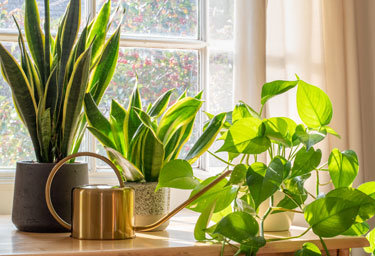
Tall and short varieties of Sanseveria with Devil's Ivy (Epipremnum aureum)
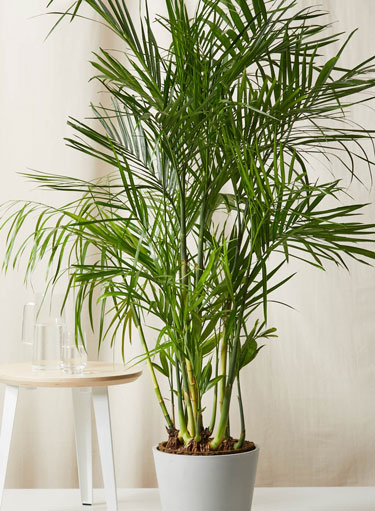
Bamboo palm (Chamaedorea seifrizii)
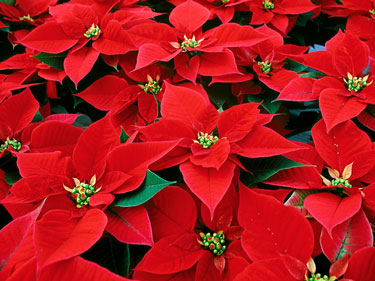
Red Poinsettia
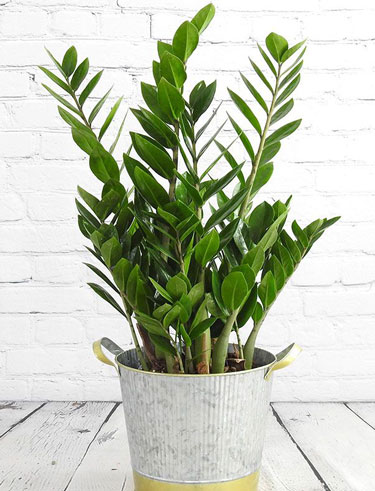
Zz plant Zanzibar Gem
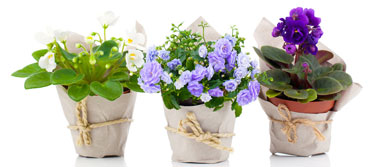
Saintpaulia - African violets
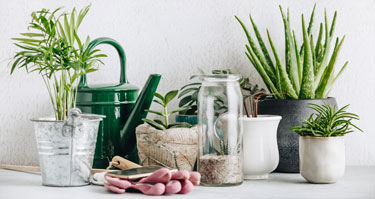
A range of containers make good cover pots
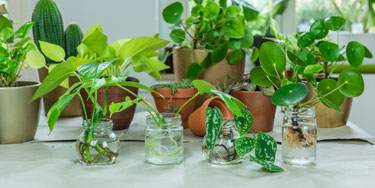
Many indoor plants can be grown from cuttings
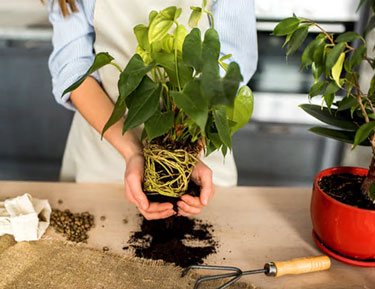
Time to repot this Anthurium

